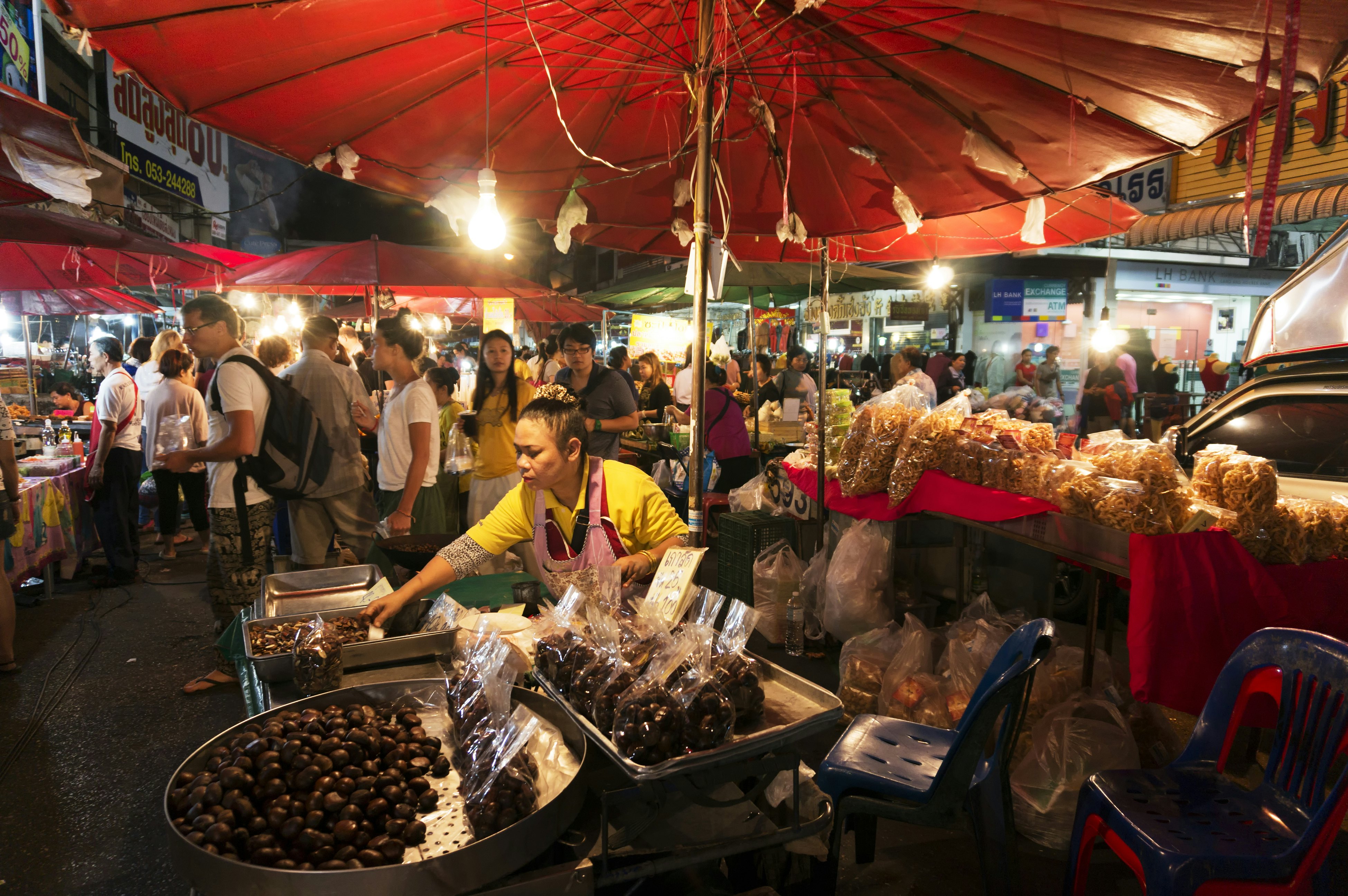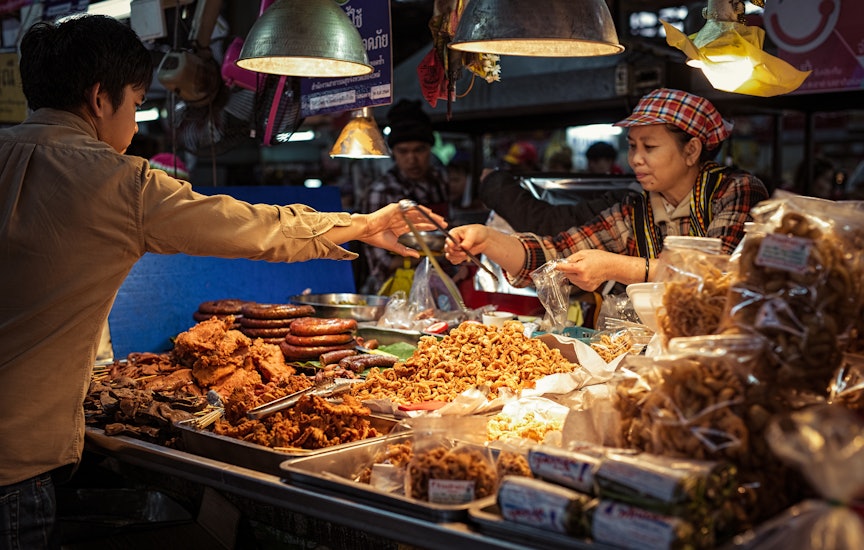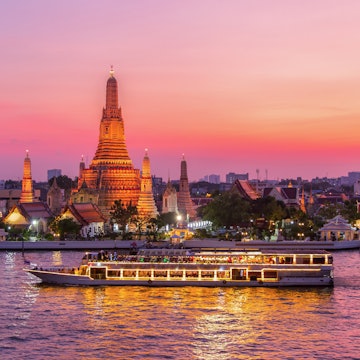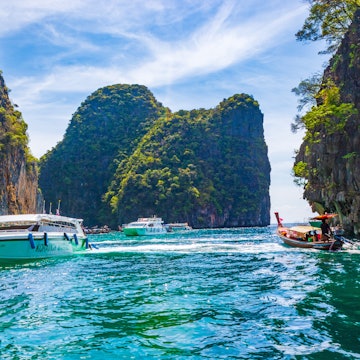
This is what you need to know about getting around Chiang Mai

Feb 24, 2025 • 7 min read

A blue tuk-tuk parked outside a restaurant in Chiang Mai. Getty Images/iStockphoto
If your first experience of traveling in Thailand was fighting through the traffic in Bangkok, prepare to be pleasantly surprised by Chiang Mai. Thailand’s northern capital offers a calmer experience, as you’ll discover once you start exploring this charming city of stupas, monasteries and markets.
The historic center of Chiang Mai – bound by a moat and the remains of the city’s medieval walls – is logically laid out and lightly trafficked, making for easy exploring. However, venturing out into the suburbs and beyond involves navigating a tangle of busy main roads and expressways. Plenty of travelers rent a motorcycle or moped and get around just fine, but it’s easier to let a chartered pickup truck do the heavy lifting.
One notable obstacle to easy road navigation is the city’s busy collection of markets. The Saturday walking street market closes Thanon Wualai to traffic on Saturday, and the Sunday walking street market does the same to Thanon Ratchadamnoen on Sunday. Things also get busy nightly around the Night Bazaar on Thanon Chang Khlan – most people get dropped off nearby and explore on foot.
Whether you plan to stick to the center or roam out to the waterfalls, hot springs, botanical gardens, palaces, and wildlife reserves in the surrounding hills, these are the best ways to get around Chiang Mai.
Getting to and from the airport is inexpensive, easy and fast
Chiang Mai is growing in popularity as the first port of arrival in Thailand, and airport transfers are easy and inexpensive. At Exit 9 from the Arrivals hall at Chiang Mai International Airport, a licensed airport taxi service runs to the old town; shuttle and minibus services are slightly cheaper, while rideshare transfers by Uber or Grab fall somewhere in the middle. When you’re leaving Chiang Mai, just ask your hotel or guesthouse to arrange a transfer, summon a rideshare or flag down a pickup truck.

The rót daang is the backbone of urban transport in Chiang Mai
Spend more than a few minutes in Chiang Mai, and you’ll spot the hordes of red-covered pickup trucks buzzing up and down the city’s streets. These rót daang (literally “red trucks” and also known as songthaew) operate as shared taxis in the center, picking up passengers heading in the direction they are going. Routes aren’t fixed, so just flag one down and ask the driver if they’re going your way. A useful tip: for trips outside the historic center, hail a rót daang heading on one of the arterial roads leading out from the city walls.
That’s not all a rót daang can do for you. Drivers also rent out their vehicles on a charter basis for taxi-style trips in town and for longer trips out to the waterfalls, temples, elephant camps and other sights in the jungle-cloaked hills around Chiang Mai. You’ll pay much more than for a shared ride, but split between a few people, a day trip by rót daang can be surprisingly affordable.
Chiang Mai’s modern bus system is the cheap option for downtown transport
Launched in 2018, the blue buses run by RTC City Bus are an affordable and convenient way to get around in central Chiang Mai. These roomy, air-conditioned buses transport passengers along nine routes, and services can be monitored in real-time via the CM Transit mobile app. There’s a flat fare of 50B Thai baht (US$1.49) per ride, which you can pay in cash or via the Rabbit stored-value card (get one from the RTC stand at the airport and recharge as needed at convenience stores).
For longer trips, head to the Chang Phueak Bus Terminal on Thanon Chotana (Thanon Chang Pheuak) for journeys to the north of Chiang Mai Province, or the Arcade Bus Terminal near the junction of Thanon Kaew Nawarat and Route 11 for other long-distance trips. There are also blue songthaew (shared pickups) running to local towns.

Tuk-tuk and cycle rickshaws are a fun way to travel
Chiang Mai’s colorful tuk-tuk (autorickshaws) offer transfers around town on a charter basis. Although popular with travelers, they’re more expensive than rót daang, and drivers sometimes steer tourists towards commission-paying stores and attractions and less salubrious nightspots. Still, riding through the traffic in a partly open cab adorned with blinking colored lights with the wind blowing through your hair is certainly an entertaining way to travel.
Old-fashioned cycle rickshaws known as samlor are clinging on in a few parts of Chiang Mai, particularly around the Talat Warorot market. Rides are inexpensive and fun, so take one to keep the tradition alive.
Taxis are inexpensive but not always easy to find
Chiang Mai does have metered taxis, but you won’t often see them cruising the streets. When in town, you can call to order a cab from CnxTaxi Chiang Mai. Rideshares are easier to track down – both Uber and Grab have drivers in town, though there are periodic attempts to shut down their services.

Rent a scooter for easy day trips outside the city
A rented scooter or motorcycle opens up a vast array of potential day trips, from excursions to the famous hilltop temple at Wat Phra That Doi Suthep to longer adventures such as the looping ride through the Mae Sa Valley and Samoeng – one of Thailand’s most enjoyable road trips. You can also buzz down to the ruins of the former Lanna kingdom capital at Wiang Kum Kam and go swimming in jungle cascades such as the so-called “Sticky Waterfall” in Si Lanna National Park.
Rental companies are dotted around the southern half of the old town, and most will ask you to leave your passport as security. To avoid problems with the police, carry your driving license and international driving permit, plus photo ID, and always wear a helmet. Some operators offer bikes without insurance – don’t risk it. At the very least, you want cover for damage to other vehicles and medical costs for anyone injured in an accident you’re involved in.
Bicycles are great for off-roading on Doi Suthep and navigating downtown
Bikes are easy to find for rent at shops and guesthouses in Chiang Mai. They’re ideal for meandering down quieter roads in the old town, but take care if you join the fast and busy roads encircling the historic center, where you’ll be competing for space with speeding rót daang, buses, cars and motorcycles.
If you want to rent a superior bike, try specialist mountain biking and cycle tour companies such as Chiang Mai Mountain Biking & Kayaks, Trailhead and Spice Roads. The closest downhill mountain biking trails are in Doi Suthep-Pui National Park, just west of the city limits; rental companies can arrange transfers to the top of the trails for you and your bike so that you can focus on the thrilling charge downhill.

Walking is the best way to explore the monasteries in the old city
Setting out on foot is arguably the best way to explore the myriad wat (monasteries) in the historic center of Chiang Mai, from famous temples such as Wat Chedi Luang, Wat Phan Tao and Wat Phra Singh to quieter monasteries in the backstreets. Just watch out for speeding motorcycles and rót daang when crossing the street.
Chiang Mai’s markets were also made for exploring on two legs. At weekends, it can feel like everyone in Chiang Mai is strolling the “walking street” markets on Thanon Wualai (Saturday) and Thanon Ratchadamnoen (Sunday); the bazaars around Talat Warorot are also fascinating to wander around on foot.
Boat trips on the Mae Ping River are strictly for fun
While plenty of produce still makes its way to market in Chiang Mai along the Mae Ping River, there isn’t much passenger traffic these days aside from the popular tourist cruises starting from Wat Chaimongkhon, south of the center on Thanon Charoen Prathet. Daytime cruises weave through the city and head south to the ruins at Wiang Kum Kam, while evening cruises are a popular choice for a floating dinner with a view.

Accessible transportation in Chiang Mai
On paper, downtown Chiang Mai should be fairly accessible, being mostly flat and not too crowded, with the exception of the busy walking street markets. However, sidewalks are narrow and often littered with obstacles (including open drain covers), pavement ramps are not always usable, few road crossings are adapted for people with disabilities, and many hotels have steps and no lift – particularly at the budget end of the spectrum. For genuinely accessible rooms, top-end places may be your only option.
Chiang Mai’s buses can accommodate wheelchairs, but if you have a folding wheelchair, it may be easier to charter a rót daang or minivan to get around. Local people are often happy to help visitors overcome obstacles, but there are advantages to traveling with a companion who can help. Note that many of Chiang Mai’s monasteries have entry steps and uneven pathways that can be a challenge for those with mobility issues.















